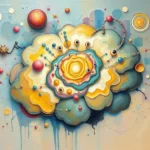
Have you ever woken up from a dream feeling as though you were on the brink of something profound, only to forget the details moments later? Dreams are like whispers from our subconscious, laden with significant symbols and messages that can illuminate our waking lives. Just as a brook meanders through the landscape, carrying along hidden treasures and reflections of the world above, our dreams flow with symbols that can guide us toward self-discovery and understanding.
In this article, we’ll explore the intricate tapestry of dream symbolism, delve into the personal experiences behind these dreams, and uncover pathways for personal growth. Let’s navigate this stream together, revealing the hidden meanings that await us in the depths of our nighttime journeys.
Symbolic Currents: Decoding the Dream Language
When it comes to dream symbolism, certain images and themes often emerge, acting as universal symbols that resonate across cultures and psychological frameworks. Dream symbols can serve as mirrors reflecting our inner thoughts, fears, and desires. Let’s consider a few common symbols and what they may signify.
-
Water: Water often represents emotions, intuition, and the unconscious mind. A calm lake may indicate tranquility, while a raging river could signify turmoil or emotional overwhelm. Different cultures interpret water in varied ways; for example, in many Native American traditions, water is seen as a source of life and healing.
-
Flying: The sensation of flying is frequently associated with freedom and liberation. It can symbolize an escape from life’s burdens or a desire to rise above challenges. Psychologically, it may represent a feeling of control over one’s life or aspirations that elevate you.
-
Chase: Dreams involving being chased reflect anxiety or avoidance. The pursuer often symbolizes a situation or emotion you are trying to escape. This can vary from fear of failure to unresolved conflicts in your life.
-
Falling: Falling dreams can evoke feelings of insecurity or loss of control. They may represent a fear of failure or a significant change in your life. Culturally, falling can symbolize a loss of status or a transition into the unknown.
-
Doors: Doors often symbolize opportunities or transitions. A locked door may represent missed opportunities or feelings of being trapped, while an open door can signify new beginnings and possibilities.
Understanding these symbols can help you decode the messages of your dreams. By recognizing what they might represent, you can start to connect them to your waking life, allowing for deeper insights into your emotional state and personal challenges.
Dreamscapes: Personal Stories from the Night
Now that we’ve examined some of the symbols, let’s explore how these themes manifest in different dream scenarios. Each scenario provides a glimpse into the dreamer’s psyche, revealing underlying emotions and experiences.
Scenario 1: The Flooded Room
Imagine dreaming of your childhood bedroom, now submerged in water. This symbolic flood could represent past emotions that you have yet to confront. The water might signify repressed feelings or memories that are surfacing. The bedroom, a sanctuary of your past, suggests that these feelings are deeply rooted in your identity. This dream invites you to explore unresolved issues from your past, allowing for healing and growth.
Scenario 2: Soaring Above the City
In this dream, you find yourself soaring above a bustling city. As you glide through the air, you feel a sense of freedom and exhilaration. This dream might reflect your current desire to break free from constraints in your life—be it work, relationships, or personal expectations. The city below represents your daily struggles, while your flight symbolizes aspirations and the need to rise above it all.
Scenario 3: The Chase Through a Maze
Picture yourself running through a maze, pursued by an unknown figure. The maze represents the complexities of your life, while the pursuit highlights feelings of anxiety or pressure. This dream may indicate that you are avoiding certain responsibilities or emotions. The unknown figure could symbolize a significant challenge you are facing. Reflecting on this dream may help you confront what you are running from and find your way through the maze.
Scenario 4: The Mysterious Door
You stand before a large, ornate door in your dreams. It is slightly ajar, inviting yet intimidating. The door symbolizes opportunity and potential changes in your life. The mystery of what lies behind it might point to a fear of the unknown or an exciting new chapter waiting to unfold. This dream encourages you to embrace the uncertainty and take a step forward into new experiences.
Scenario 5: The Ground Crumbling
In this unsettling dream, the ground beneath your feet begins to crumble, and you feel a sense of panic. This imagery is often tied to feelings of instability or insecurity in your waking life. It may reflect changes that are beyond your control, such as job loss or a relationship shift. This dream serves as a reminder to find solid ground within yourself and seek support during turbulent times.
By examining these scenarios, you can glean insights into your emotional landscape and daily challenges. Each dream serves as a narrative that reflects your current state of mind, urging you to take a closer look at the experiences that shape you.
Flowing Forward: Embracing Personal Transformation
Dreams are not merely a collection of random images; they are a pathway to personal growth and transformation. Engaging with your dreams can lead to profound self-discovery and insight. Here are some practical steps to harness the power of your dreams for personal development.
1. Keep a Dream Journal
Start by recording your dreams in a journal. Write down the details as soon as you wake up—include emotions, symbols, and any significant events from your waking life. This practice can enhance your recall and help you identify recurring themes over time.
2. Reflect on Your Feelings
Take time to reflect on the emotions associated with your dreams. Ask yourself what these feelings might reveal about your current situation. Are there aspects of your life that feel overwhelming? Are there opportunities you’re hesitant to pursue? Understanding your emotions is key to decoding your dreams.
3. Explore Symbolism
Use resources to explore dream symbolism further. Books, online tools, or communities dedicated to dream analysis can provide valuable insights into the meanings of your dreams. Understanding common symbols can add layers to your interpretations.
4. Engage with Your Dream Themes
Consider how the themes of your dreams might manifest in your waking life. If you frequently dream of flying, think about areas where you feel empowered or free. If you find yourself in a maze, evaluate the challenges you’re facing and whether you’re avoiding them.
5. Take Action
Dreams can serve as catalysts for change. If your dream highlights a particular fear or desire, consider taking steps to address it. Whether it’s initiating a difficult conversation, pursuing a passion project, or seeking support, taking action can ground the insights gained from your dreams into your reality.
Embracing your dreams and their messages can lead to a deeper understanding of yourself and your life’s journey. Remember, the brook of your subconscious is always flowing, carrying with it insights waiting to be discovered.
As you reflect on your dreams, consider this: What do your dreams reveal about who you are and who you aspire to be? By tuning in to the whispers of your subconscious, you can navigate your life more authentically and embrace the opportunities that flow your way.







